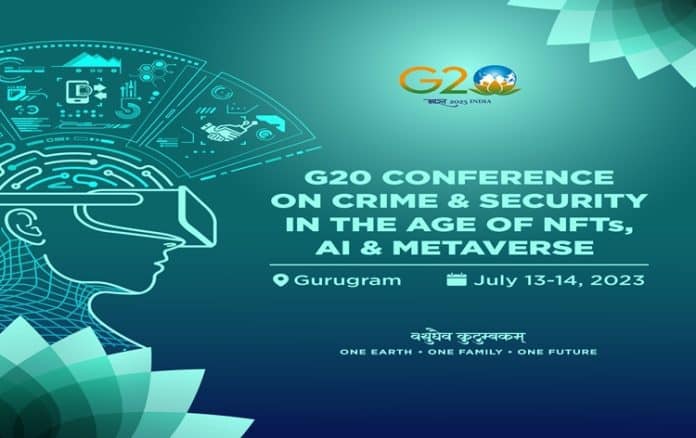What’s in today’s article?
- Why in News?
- Understanding Metaverse and NFTs (non-fungible tokens)
- Need for the Conference on Crime and Security
- How Vulnerable India and Other Countries are?
- Way Ahead
- Conclusion
Why in News?
- The inaugural session of the G20 conference on ‘Crime and Security in the age of NFTs, AI and Metaverse’, was recently held in Gurugram, India.
- This summit is a new and unique initiative of the G-20 Presidency, and is the first conference on cyber security in the G-20.
Understanding Metaverse and NFTs (non-fungible tokens):
- The metaverse is a concept of a virtual shared space where users can interact with each other and digital objects in a seemingly real way.
- NFTs are digital assets that can be used to represent unique items, such as virtual real estate, in-game items and collectibles, on a blockchain.
Need for the Conference on Crime and Security:
- In the wake of the digital age, cyber security has become an essential aspect of global security that requires adequate attention to its economic and geopolitical implications.
- The transformation of security challenges from ‘dynamite to metaverse’ and from ‘conversion of hawala to cryptocurrency’ led to the need to devise a common strategy against it.
- Terrorists are finding new ways (darknet, metaverse, cryptocurrency) to perpetrate violence, radicalise youth and raise financial resources and new methods in virtual assets are being used by terrorists for financial transactions.
- This will make it easier for terrorist organisations to select and target vulnerable people and prepare material according to their vulnerabilities.
- The metaverse also creates opportunities for true imitation of a user’s identity, known as deep-fakes. These can be used to impersonate users and steal their identities.
How Vulnerable India and Other Countries are?
- Many countries have become victims of cyber-attacks and this threat is hovering over all major economies.
- The World Bank estimates that cyber-attacks could have caused losses of around $5.2 trillion to the world during 2019-2023.
- According to the Global Trend Summary Report 2022, some of the cybercrime trends, such as ransomware, phishing, online scams, online child sexual abuse and hacking, will increase manifold in the future.
- 840 million Indians have an online presence, and by 2025 another 400 million Indians will enter the digital world. The possibilities of cyber threats have also increased.
Way Ahead:
- It is essential to strengthen the capabilities of nations and international organisations to deal with new and emerging, traditional and non-traditional challenges, including –
- Terrorism, terror financing,
- Radicalisation,
- Narco, narco-terror links, and
- Misinformation in a better way.
- In order to create a robust and efficient operational system, there is the need to think in a timely manner using a coordinated and cooperative approach on using various virtual assets.
Conclusion:
- Today, technology has transcended all conventional geographical, political and economic boundaries, and we live in a big global digital village.
- The G-20 has focused on digital transformation and data flow from an economic perspective, but now it is very important to understand the aspects of crime and security and find a solution.
Q1) What are deepfakes?
Deepfakes are synthetic media that have been digitally manipulated to replace one person’s likeness convincingly with that of another. It leverages powerful techniques from ML and AI to manipulate or generate visual and audio content that can more easily deceive.
Q2) What is darknet?
A darknet is an overlay network within the Internet that can only be accessed with specific software, configurations, or authorization, and often uses a unique customised communication protocol.
Last updated on December, 2025
→ Check out the latest UPSC Syllabus 2026 here.
→ Join Vajiram & Ravi’s Interview Guidance Programme for expert help to crack your final UPSC stage.
→ UPSC Mains Result 2025 is now out.
→ UPSC Notification 2026 is scheduled to be released on January 14, 2026.
→ UPSC Calendar 2026 is released on 15th May, 2025.
→ The UPSC Vacancy 2025 were released 1129, out of which 979 were for UPSC CSE and remaining 150 are for UPSC IFoS.
→ UPSC Prelims 2026 will be conducted on 24th May, 2026 & UPSC Mains 2026 will be conducted on 21st August 2026.
→ The UPSC Selection Process is of 3 stages-Prelims, Mains and Interview.
→ UPSC Result 2024 is released with latest UPSC Marksheet 2024. Check Now!
→ UPSC Prelims Result 2025 is out now for the CSE held on 25 May 2025.
→ UPSC Toppers List 2024 is released now. Shakti Dubey is UPSC AIR 1 2024 Topper.
→ UPSC Prelims Question Paper 2025 and Unofficial Prelims Answer Key 2025 are available now.
→ UPSC Mains Question Paper 2025 is out for Essay, GS 1, 2, 3 & GS 4.
→ UPSC Mains Indian Language Question Paper 2025 is now out.
→ UPSC Mains Optional Question Paper 2025 is now out.
→ Also check Best IAS Coaching in Delhi

















